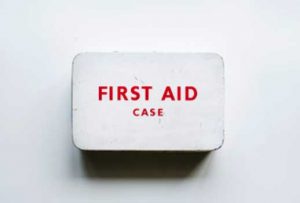Horses are inquisitive creatures and their natural flight response often leads them to being accident prone. Anyone who owns horses understands the anxiety and helplessness we feel when something goes wrong with our beloved companions. When it comes to equine emergencies, having a clear plan in place can go a long way toward a good outcome for your equine friend.
To make highly stressful situations more manageable it is advised to have your Vet’s number programmed into your phone, a well-stocked first aid kit on hand and a good plan in place to give your horse the best chance possible of a speedy recovery.
Following a few simple steps can help you plan and deal with an emergency if one may arise:
- Assess the situation and remember to put your own safety first. Even the quietest horse can react violently or out of character when it is sick or injured.
- To help prevent further injury, secure the horse and guide it to a place of safety that is clean. If a horse is showing signs of illness it is a good idea to have a quarantine area to help prevent the spread of disease to other animals.
- Keep your equine first aid kit in a handy location (it is a good idea to have one in your horse float as well for when you travel) and make sure contents are kept stocked and up to date.
- Examine the entire horse and call your Veterinarian if needed.
- Proceed with emergency medical treatment – this will be situation dependent.
- Remember if in doubt CALL YOUR VET and follow their advice.
- Try to identify the cause of injury and take preventative measures to help avoid the incident from happening again.
More About Equine First Aid Kits
The role of a first aid kit is to help you treat the most common problems and stabilise any more serious injuries until your Vet arrives. The kit should be kept in a clean, sturdy and closable container and be readily accessible. Do your research, as many of the necessary items can be purchased from regular discount pharmacies to help you save money. It is also a good idea to keep a laminated list of contents inside the lid along with important phone numbers including yours, your Vet and your Farrier in case you have someone else looking after your horses while you are away from home.
Following are some suggested items to include in your equine first aid kit:

- Halter and lead rope
- Bandaging supplies
- A set of stable bandages
- 4 rolls of self-adhesive bandages
- A variety of non-adhesive dressings
- Disposable nappies or sanitary napkins to act as pressure pads to stop bleeding
- A roll of cotton wool
- Gauze swabs
- A roll of duct tape or electrical tape
- Poultice
- Wound cleaning agent such as povidone iodine
- A bottle of antibacterial spray e.g. Cetrigen
- Antibacterial cream/ointment e.g. Septicide
- Sterile saline
- Epsom salts and plain salt
- Fly repellent
- Petroleum jelly
- Latex gloves
- Torch
- Clean towel
- Hoof pick
- Tweezers
- Thermometer (normal 37-38.5°C)
- Scissors
- Clean plastic bucket
- First aid book
- Clean 60mL syringe
- Stethoscope (used for monitoring heart rate and gut sounds – ask your Vet how)
For further advice on what to include in your equine first aid kit, ask your Vet on their next routine visit.
